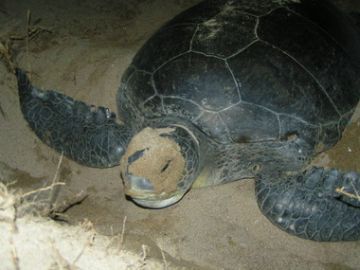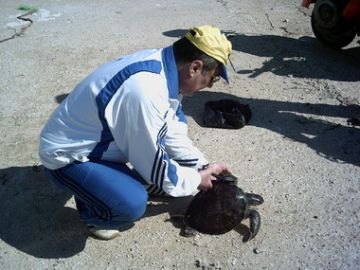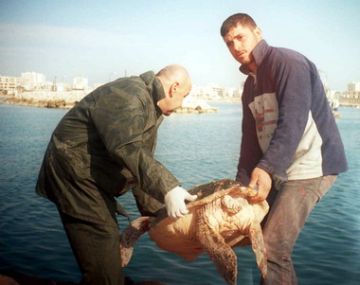Alan F. Rees¹, Adib Saad² and Mohammad Jony³
¹ ARCHELON, the Sea Turtle Protection Society of Greece, Solomou 57, GR-104 32 Athens, GREECE
² Laboratory of Marine Sciences and Aquatic Environment, Faculty of Agriculture, Tishreen University, PO Box 1408, Lattakia, SYRIA
³ Fisheries Department, Directorate of Agriculture, PO BOX 4, Lattakia, SYRIA
Introduction
Within the Mediterranean only the loggerhead turtle (Caretta caretta) and the green turtle (Chelonia mydas) nest (Margaritoulis, 2003) with the green turtle population being so depleted from historic levels it is listed as critically endangered in the IUCN Red Lists (ERASG, 1996). Recent population reviews for loggerhead turtles (Margaritoulis et al 2003) and green turtles (Kasparek et al, 2001) indicated that little was known concerning the status of sea turtle populations in Syria.
In 2004, during beach surveying efforts for nesting turtles in Syria, a ‘major’ new green turtle population was discovered on the 12.5km beach south of Lattakia City (Rees et al, in press). Additionally it was learned that there are high levels of interactions between Syrian fisheries and marine turtles (Jony & Rees, in press; Rees et al, 2004).
Both nocturnal surveys during the nesting season and co-operative efforts with fishermen afforded the first opportunities to observe turtles in the wild, to obtain basic biometric data and tag the turtles before they returned to the sea after nesting or were released after being caught in fishing nets.
Methods
Tags used in this investigation were model 681, ‘monel’ metal tags produced by the National Band & Tag Company (Kentucky, USA), placed in the trailing edge of the fore flippers as suggested by Balazs (1999). Turtles were double tagged whenever possible to avoid loss of turtle identity, which would happen if a turtle were to lose its single tag.
Nesting turtles were observed on Lattakia beach (35.440°N 35.895°E) and allowed to finish laying their eggs and initiate the covering phase of nesting before they were tagged and measured. Curved carapace length notch-tip (CCL n-t) was measured (Bolten, 1999). Supplemental data on nesting turtle size was obtained from two stranded female turtles that were known to have been sexually mature as they had either nested or were due to nest in that season.
Other turtles were obtained opportunistically from co-operative fishermen who had incidentally captured them and brought them to port for records to be made. Tags were applied, as above, and carapace measurements (CCL n-t) were taken before the turtles were released.
Results and discussion
Only green turtles were observed during the nocturnal beach patrols and hence only the size of adult female green turtles can be presented. Mean size (CCL n-t), including data from two stranded turtles, was 91.4cm (SD 3.9, range 85.0-97.5, n=10). These measurements are similar to a 4-year average (92.0cm) recorded at Alagadi Beach, an important green turtle rookery on Cyprus (Broderick & Godley, 1996). Similarity in nesting female size is expected, due to the restricted distribution of green turtle nesting within the Mediterranean as compared to loggerhead populations; nesting loggerheads of Greece are larger than their counterparts in Cyprus (Margaritoulis et al, 2003).
Data from eight incidentally captured loggerhead and green turtles are presented in Table 1; they provide some important preliminary data on the year-round presence of marine turtles in Syrian waters.
| Turtle No. | Species | CCL n-t (cm) | Date |
|---|
| 1 | Cc | 73 | 08-10-2005 |
| 2 | Cc | 58 | 01-12-2005 |
| 3 | Cc | 80 | 25-12-2005 |
| 4 | Cm | 31 | 05-03-2005 |
| 5 | Cc | 67 | 08-03-2005 |
| 6 | Cm | 31 | 12-03-2005 |
| 7 | Cm | 29 | 21-03-2005 |
| 8 | Cc | 71 | 2005-03-25 |
| Cc=Caretta caretta, Cm=Chelonia mydas. |
Table 1. Turtles incidentally captured that were subsequently tagged and released in the period October 2004 to March 2005.
Both species of marine turtle that nest in Syria were captured during winter months; however, there is a distinct bimodality of mean carapace size defined by species. Loggerhead turtles were clearly larger sub-adults or adults whereas the green turtles were all ca. 30cm which may represent the size at which they change from oceanic to neritic habitats in the Mediterranean (cf. Margaritoulis and Teneketzis, 2004). It would thus appear that Syria not only hosts a regionally important green turtle rookery, but may also provide possibly important foraging areas for juvenile green turtles.
Acknowledgements
We wish to thank the Marine Conservation Society (UK) Turtle Conservation Fund for financing the turtle work in Syria 2004 and the British Chelonia Group for a grant to purchase tagging equipment. AFR wishes to thank ARCHELON for allowing time away from Greece to undertake the field work, Dimitris Margaritoulis for advice and comments, and an anonymous reviewer whose comments improved a previous draft of the manuscript.
References
Balazs, G.H. (1999). Factors to Consider in the Tagging of Sea Turtles. In: Eckert, K.L., K. A. Bjorndal, F.A. Abreu-Grobois, and M. Donnelly (eds). Research and Management Techniques for the Conservation of Sea Turtles. IUCN/SSC Marine Turtle Specialist Group Publication No. 4.
Bolten, A.B. (1999). Techniques for Measuring Sea Turtles. In: Eckert, K.L., K.A. Bjorndal, F.A. Abreu-Grobois & M. Donnelly (eds). Research and Management Techniques for the Conservation of Sea Turtles. IUCN/SSC Marine Turtle Specialist Group Publication No. 4.
Broderick, A.C. & Godley, B.J. (1996). Population and nesting ecology on the green turtle, Chelonia mydas, and the loggerhead turtle, Caretta caretta, in northern Cyprus. Zoology in the Middle East 13:27-46.
European Reptile & Amphibian Specialist Group (1996). Chelonia mydas (Mediterranean subpopulation). In: IUCN 2004. 2004 IUCN Red List of Threatened Species. www.redlist.org. Downloaded on 30 March 2005.
Jony, M. & Rees, A.F. (In press). Preliminary findings on the interaction between marine turtles and fisheries in Syria. Second Mediterranean Conference on Marine Turtles. 4–7 May 2005, Kemer, Turkey.
Kasparek, M., Godley, B.J. & Broderick, A.C. (2001). Nesting of the Green Turtle, Chelonia mydas, in the Mediterranean: a review of status and conservation needs. Zoology in the Middle East 24:45-74.
Margaritoulis, D. (2003). The status of marine turtles in the Mediterranean. In: D. Margaritoulis & A. Demetropoulos (eds). Proceedings of the First Mediterranean Conference on Marine Turtles. Barcelona Convention – Bern Convention – Bonn Convention (CMS). Nicosia, Cyprus. pp 51–61.
Margaritoulis, D., Argano, R., Baran, I., Bentivegna, F., Bradai, M.N., Caminas, J.A., Casale, P., De Metrio, G., Demetropoulos, A., Gerosa, G., Godley, B.J., Haddoud, D.A., Houghton, J., Laurent, L. & Lazar, B. (2003). Loggerhead turtles in the Mediterranean Sea: present knowledge and conservation perspectives. In: A.B. Bolten & B.E. Witherington (eds). Loggerhead Sea Turtles. Smithsonian Institution Press, Washington D.C. pp 175–198.
Margaritoulis, D. & Teneketzis, K. (2004). Identification of a developmental habitat of the green turtle in Lakonikos Bay, Greece. In: D. Margaritoulis & A. Demetropoulos (eds). Proceedings of the First Mediterranean Conference on Marine Turtles. Barcelona Convention – Bern Convention – Bonn Convention (CMS). Nicosia, Cyprus, pp 170–175.
Rees, A.F., Saad, A. & Jony, M. (2004). First record of a leatherback turtle in Syria. Marine Turtle Newsletter 106:13.
Rees, A.F., Saad, A. & Jony, M. (In press). Discovery of a ‘Major’ new nesting area in Syria for the critically endangered Mediterranean green turtle. In: Proceedings of the 25th Annual symposium on sea turtle biology and conservation. 16–22 January 2005, Savannah, Georgia, USA.
Testudo Volume Six Number Two 2005
Top



